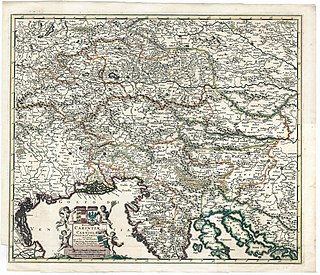
The history of Slovenia chronicles the period of the Slovenian territory from the 5th century BC to the present. In the Early Bronze Age, Proto-Illyrian tribes settled an area stretching from present-day Albania to the city of Trieste. The Slovenian territory was part of the Roman Empire, and it was devastated by the Migration Period's incursions during late Antiquity and the Early Middle Ages. The main route from the Pannonian plain to Italy ran through present-day Slovenia. Alpine Slavs, ancestors of modern-day Slovenians, settled the area in the late 6th Century AD. The Holy Roman Empire controlled the land for nearly 1,000 years, and between the mid-14th century and 1918 most of Slovenia was under Habsburg rule. In 1918, most Slovene territory became part of the Kingdom of Serbs, Croats, and Slovenes, and in 1929 the Drava Banovina was created within the Kingdom of Yugoslavia with its capital in Ljubljana, corresponding to Slovenian-majority territories within the state. The Socialist Republic of Slovenia was created in 1945 as part of federal Yugoslavia. Slovenia gained its independence from Yugoslavia in June 1991, and today it is a member of the European Union and NATO.

The Slovenes, also known as Slovenians, are a South Slavic ethnic group native to Slovenia, and adjacent regions in Italy, Austria and Hungary. Slovenes share a common ancestry, culture, history and speak Slovene as their native language. They are closely related to other South Slavic ethnic groups, as well as more distantly to West Slavs.
Scoutingin Slovenia is served by three associations:

United Slovenia is the name originally given to an unrealized political programme of the Slovene national movement, formulated during the Spring of Nations in 1848. The programme demanded (a) unification of all the Slovene-inhabited areas into one single kingdom under the rule of the Austrian Empire, (b) equal rights of Slovene in public, and (c) strongly opposed the planned integration of the Habsburg monarchy with the German Confederation. The programme failed to meet its main objectives, but it remained the common political program of all currents within the Slovene national movement until World War I.

The Slovene Littoral or simply Littoral is one of the traditional regions of Slovenia. The littoral in its name – for a coastal-adjacent area – recalls the former Austrian Littoral, the Habsburg possessions on the upper Adriatic coast, of which the Slovene Littoral was part. Today, the Littoral is often associated with the Slovenian ethnic territory that, in the first half of the 20th century, found itself in Italy to the west of the Rapallo Border, which separated a quarter of Slovenes from the rest of the nation, and was strongly influenced by Italian fascism.
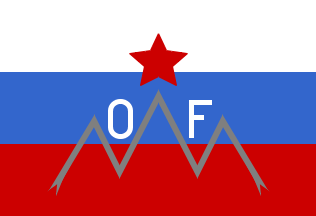
The Liberation Front of the Slovene Nation, or simply Liberation Front, originally called the Anti-Imperialist Front, was a Slovene anti-fascist political party. The Anti-Imperialist Front had ideological ties to the Soviet Union in its fight against the imperialistic tendencies of the United States and the United Kingdom, and it was led by the Communist Party of Slovenia. In May 1941, weeks into the German occupation of Yugoslavia, in the first wartime issue of the illegal newspaper Slovenski poročevalec, members of the organization criticized the German regime and described Germans as imperialists. They started raising money for a liberation fund via the second issue of the newspaper published on 8 June 1941. When Germany attacked the Soviet Union, the Anti-Imperialist Front was formally renamed and became the main anti-fascist Slovene civil resistance and political organization under the guidance and control of the Slovene communists. It was active in the Slovene Lands during World War II. Its military arm was the Slovene Partisans. The organisation was established in the Province of Ljubljana on 26 April 1941 in the house of the literary critic Josip Vidmar. Its leaders were Boris Kidrič and Edvard Kardelj.
Carinthian Slovenes or Carinthian Slovenians are the indigenous minority of Slovene ethnicity, living within borders of the Austrian state of Carinthia, neighboring Slovenia. Their status of the minority group is guaranteed in principle by the Constitution of Austria and under international law, and have seats in the National Ethnic Groups Advisory Council.

The Slovene lands or Slovenian lands is the historical denomination for the territories in Central and Southern Europe where people primarily spoke Slovene. The Slovene lands were part of the Illyrian provinces, the Austrian Empire and Austria-Hungary. They encompassed Carniola, southern part of Carinthia, southern part of Styria, Istria, Gorizia and Gradisca, Trieste, and Prekmurje. Their territory more or less corresponds to modern Slovenia and the adjacent territories in Italy, Austria, Hungary, and Croatia, where autochthonous Slovene minorities live. In the areas where present-day Slovenia borders to neighboring countries, they were never homogeneously ethnically Slovene.
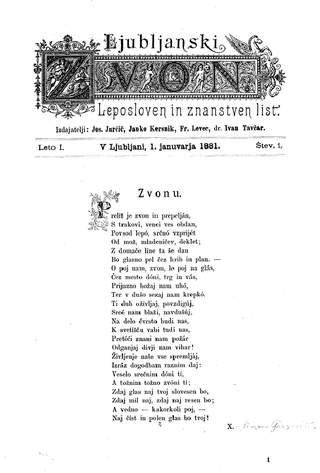
Ljubljanski zvon was a journal published in Ljubljana in Slovene between 1881 and 1941. It was considered one of the most prestigious literary and cultural magazines in Slovenia.

Bogumil Vošnjak, also known as Bogomil Vošnjak, was a Slovene and Yugoslav jurist, politician, diplomat, author, and legal historian. He often wrote under the pseudonym Illyricus.

Izidor Cankar was a Slovenian author, art historian, diplomat, journalist, translator, and liberal conservative politician. He was one of the most important Slovenian art historians of the first part of the 20th century, and one of the most influential cultural figures in interwar Slovenia.
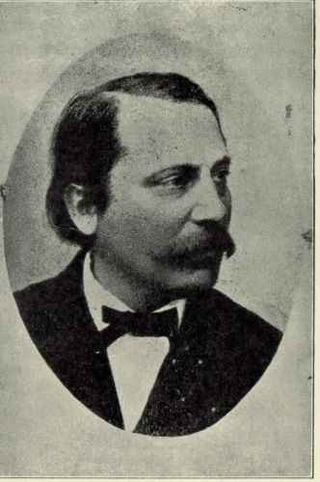
Karel Lavrič, also spelled Laurič or Lauritsch, was a Carniolan liberal politician and lawyer from the Austrian Littoral. He was of Slovene descent and was one of the most prominent activists of the Young Slovene movement. Together with the conservative Lovro Toman, he was considered among the most popular Slovene politicians of the 19th century. He was also called the 'tribune of Goriška'.
Boris Furlan was a Slovenian jurist, philosopher of law, translator and liberal politician. During World War II, he worked as a speaker on Radio London, and was known as "London's Slovene voice". He served as a Minister in the Tito–Šubašić coalition government. In 1947, he was convicted by the Yugoslav Communist authorities at the Nagode Trial.
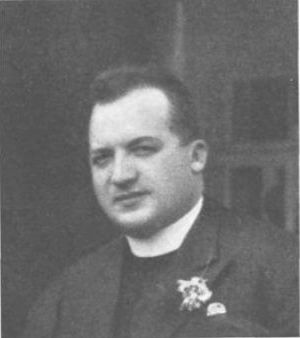
Alojzij Kuhar was a Slovenian and Yugoslav politician, diplomat, historian and journalist. Together with Izidor Cankar and Franc Snoj, he was an important exponent of the liberal conservative fraction of the Slovene People's Party.

Kmetijske in rokodelske novice, frequently referred to simply as Novice (News), was a Slovene-language newspaper in the 19th century, which had an influential role in the Slovene national revival. For its first two years of publication (1843–1844) the newspaper's name was spelled Kmetijſke in rokodélſke novize, and from 1845 onward Kmetijske in rokodélske novice.
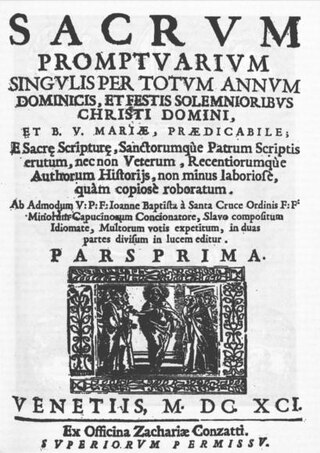
Tobia Lionelli was a Slovene–Italian preacher and writer in the Baroque period. His sermons had a crucial role in the affirmation of Slovene as a language. He is also known by his monastic name John Baptist of Sveti Križ in Vipava.

Engelbert Besednjak was a Slovene Christian Democrat politician, lawyer and journalist. In the 1920s, he was one of the leaders of the Slovene and Croat minority in the Italian-administered Julian March. In the 1930s, he was one of the leaders of Slovene anti-Fascist émigrés from the Slovenian Littoral, together with Josip Vilfan, Ivan Marija Čok and Lavo Čermelj.
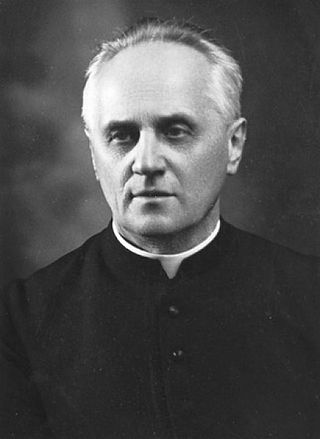
Lambert Ehrlich was a Carinthian Slovene Roman Catholic priest, political figure, and ethnologist.
Slovene minority in Italy, also known as Slovenes in Italy is the name given to Italian citizens who belong to the autochthonous Slovene ethnic and linguistic minority living in the Italian autonomous region of Friuli-Venezia Giulia. The vast majority of members of the Slovene ethnic minority live in the Provinces of Trieste, Gorizia, and Udine. Estimates of their number vary significantly; the official figures show 52,194 Slovenian speakers in Friuli-Venezia Giulia, as per the 1971 census, but Slovenian estimates speak of 83,000 to 100,000 people.














